Discovering Intentions and Desires within Knowledge Intensive Processes
VerifiedAdded on 2023/06/12
|12
|2868
|118
AI Summary
The report discusses the concept of KIP or Knowledge Intensive Process and its importance in various businesses. The discussion section discusses the intent analysis and compares it with sentiment analysis. A case study has been evaluated and the issues have been highlighted. The research method has been discussed effectively in the report.
Contribute Materials
Your contribution can guide someone’s learning journey. Share your
documents today.
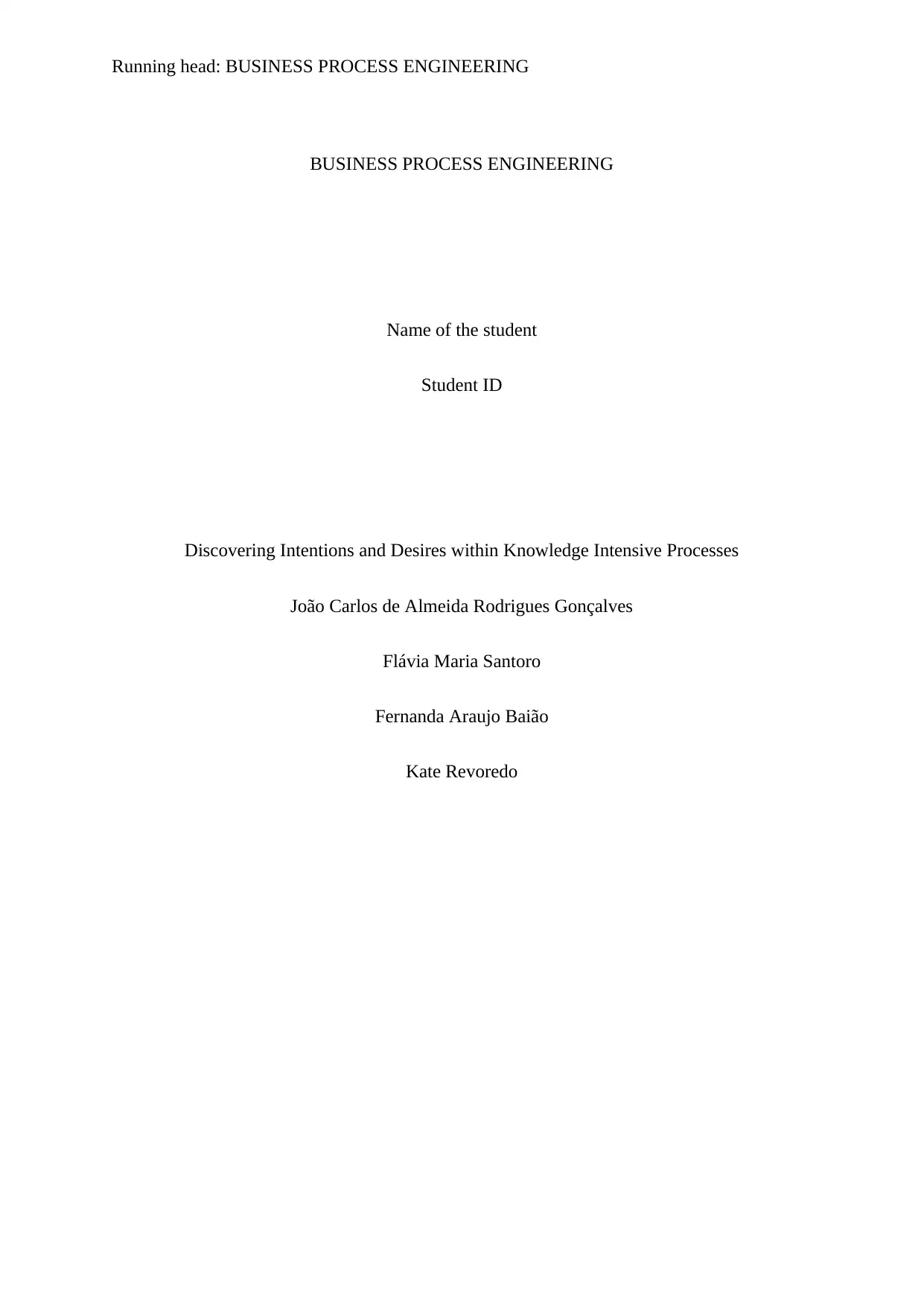
Running head: BUSINESS PROCESS ENGINEERING
BUSINESS PROCESS ENGINEERING
Name of the student
Student ID
Discovering Intentions and Desires within Knowledge Intensive Processes
João Carlos de Almeida Rodrigues Gonçalves
Flávia Maria Santoro
Fernanda Araujo Baião
Kate Revoredo
BUSINESS PROCESS ENGINEERING
Name of the student
Student ID
Discovering Intentions and Desires within Knowledge Intensive Processes
João Carlos de Almeida Rodrigues Gonçalves
Flávia Maria Santoro
Fernanda Araujo Baião
Kate Revoredo
Secure Best Marks with AI Grader
Need help grading? Try our AI Grader for instant feedback on your assignments.

1BUSINESS PROCESS ENGINEERING
Table of Contents
Table of Contents
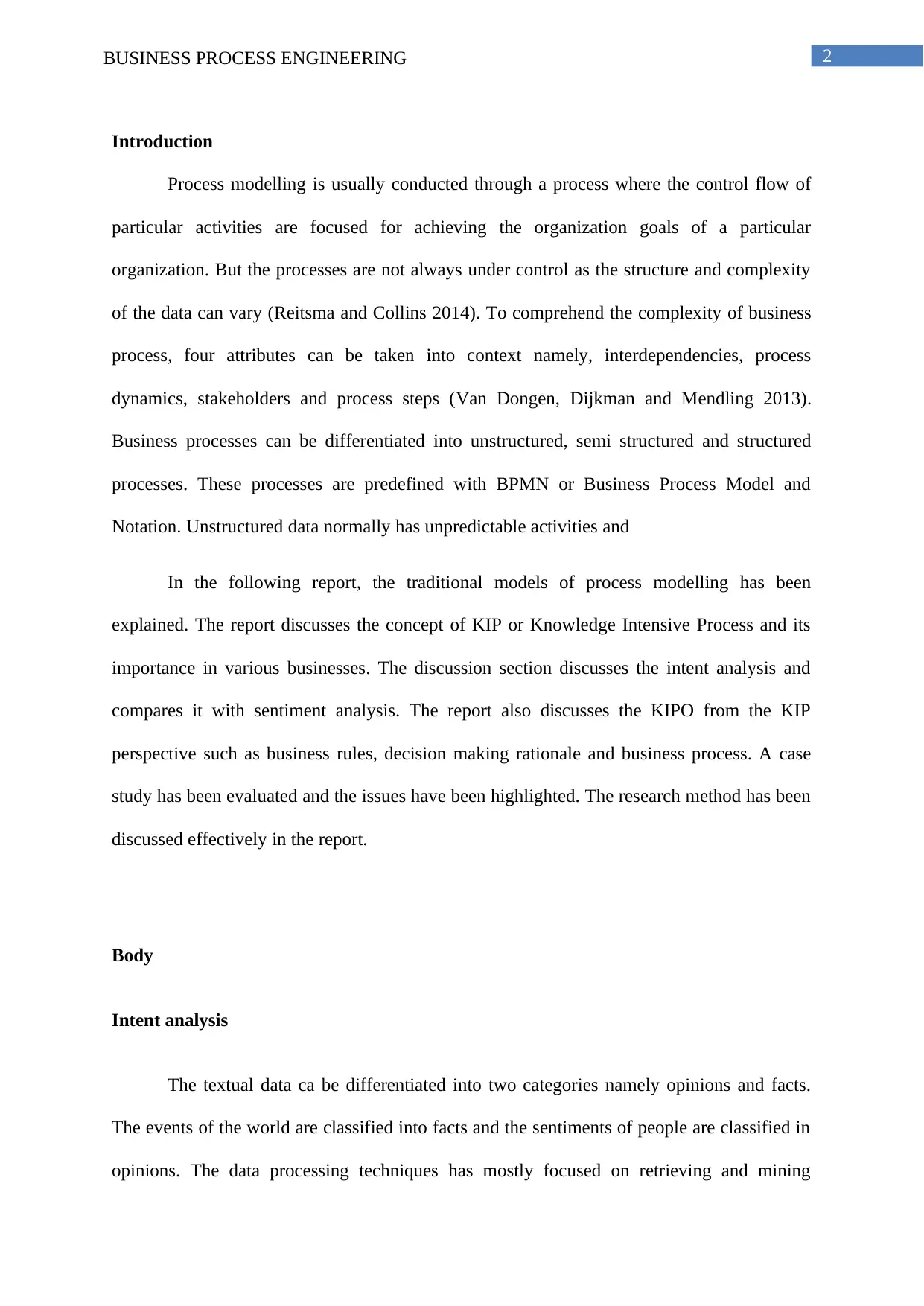
2BUSINESS PROCESS ENGINEERING
Introduction
Process modelling is usually conducted through a process where the control flow of
particular activities are focused for achieving the organization goals of a particular
organization. But the processes are not always under control as the structure and complexity
of the data can vary (Reitsma and Collins 2014). To comprehend the complexity of business
process, four attributes can be taken into context namely, interdependencies, process
dynamics, stakeholders and process steps (Van Dongen, Dijkman and Mendling 2013).
Business processes can be differentiated into unstructured, semi structured and structured
processes. These processes are predefined with BPMN or Business Process Model and
Notation. Unstructured data normally has unpredictable activities and
In the following report, the traditional models of process modelling has been
explained. The report discusses the concept of KIP or Knowledge Intensive Process and its
importance in various businesses. The discussion section discusses the intent analysis and
compares it with sentiment analysis. The report also discusses the KIPO from the KIP
perspective such as business rules, decision making rationale and business process. A case
study has been evaluated and the issues have been highlighted. The research method has been
discussed effectively in the report.
Body
Intent analysis
The textual data ca be differentiated into two categories namely opinions and facts.
The events of the world are classified into facts and the sentiments of people are classified in
opinions. The data processing techniques has mostly focused on retrieving and mining
Introduction
Process modelling is usually conducted through a process where the control flow of
particular activities are focused for achieving the organization goals of a particular
organization. But the processes are not always under control as the structure and complexity
of the data can vary (Reitsma and Collins 2014). To comprehend the complexity of business
process, four attributes can be taken into context namely, interdependencies, process
dynamics, stakeholders and process steps (Van Dongen, Dijkman and Mendling 2013).
Business processes can be differentiated into unstructured, semi structured and structured
processes. These processes are predefined with BPMN or Business Process Model and
Notation. Unstructured data normally has unpredictable activities and
In the following report, the traditional models of process modelling has been
explained. The report discusses the concept of KIP or Knowledge Intensive Process and its
importance in various businesses. The discussion section discusses the intent analysis and
compares it with sentiment analysis. The report also discusses the KIPO from the KIP
perspective such as business rules, decision making rationale and business process. A case
study has been evaluated and the issues have been highlighted. The research method has been
discussed effectively in the report.
Body
Intent analysis
The textual data ca be differentiated into two categories namely opinions and facts.
The events of the world are classified into facts and the sentiments of people are classified in
opinions. The data processing techniques has mostly focused on retrieving and mining
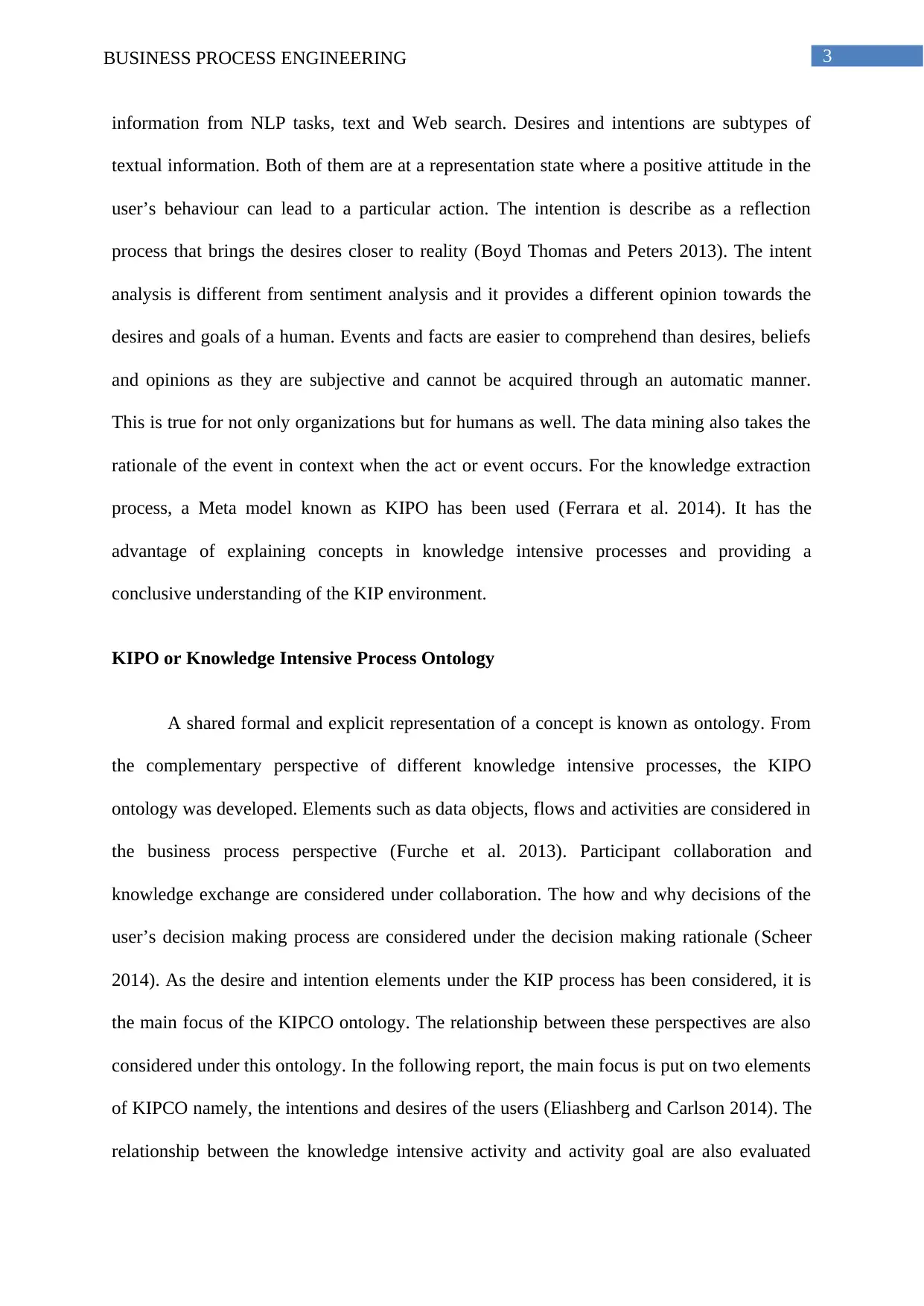
3BUSINESS PROCESS ENGINEERING
information from NLP tasks, text and Web search. Desires and intentions are subtypes of
textual information. Both of them are at a representation state where a positive attitude in the
user’s behaviour can lead to a particular action. The intention is describe as a reflection
process that brings the desires closer to reality (Boyd Thomas and Peters 2013). The intent
analysis is different from sentiment analysis and it provides a different opinion towards the
desires and goals of a human. Events and facts are easier to comprehend than desires, beliefs
and opinions as they are subjective and cannot be acquired through an automatic manner.
This is true for not only organizations but for humans as well. The data mining also takes the
rationale of the event in context when the act or event occurs. For the knowledge extraction
process, a Meta model known as KIPO has been used (Ferrara et al. 2014). It has the
advantage of explaining concepts in knowledge intensive processes and providing a
conclusive understanding of the KIP environment.
KIPO or Knowledge Intensive Process Ontology
A shared formal and explicit representation of a concept is known as ontology. From
the complementary perspective of different knowledge intensive processes, the KIPO
ontology was developed. Elements such as data objects, flows and activities are considered in
the business process perspective (Furche et al. 2013). Participant collaboration and
knowledge exchange are considered under collaboration. The how and why decisions of the
user’s decision making process are considered under the decision making rationale (Scheer
2014). As the desire and intention elements under the KIP process has been considered, it is
the main focus of the KIPCO ontology. The relationship between these perspectives are also
considered under this ontology. In the following report, the main focus is put on two elements
of KIPCO namely, the intentions and desires of the users (Eliashberg and Carlson 2014). The
relationship between the knowledge intensive activity and activity goal are also evaluated
information from NLP tasks, text and Web search. Desires and intentions are subtypes of
textual information. Both of them are at a representation state where a positive attitude in the
user’s behaviour can lead to a particular action. The intention is describe as a reflection
process that brings the desires closer to reality (Boyd Thomas and Peters 2013). The intent
analysis is different from sentiment analysis and it provides a different opinion towards the
desires and goals of a human. Events and facts are easier to comprehend than desires, beliefs
and opinions as they are subjective and cannot be acquired through an automatic manner.
This is true for not only organizations but for humans as well. The data mining also takes the
rationale of the event in context when the act or event occurs. For the knowledge extraction
process, a Meta model known as KIPO has been used (Ferrara et al. 2014). It has the
advantage of explaining concepts in knowledge intensive processes and providing a
conclusive understanding of the KIP environment.
KIPO or Knowledge Intensive Process Ontology
A shared formal and explicit representation of a concept is known as ontology. From
the complementary perspective of different knowledge intensive processes, the KIPO
ontology was developed. Elements such as data objects, flows and activities are considered in
the business process perspective (Furche et al. 2013). Participant collaboration and
knowledge exchange are considered under collaboration. The how and why decisions of the
user’s decision making process are considered under the decision making rationale (Scheer
2014). As the desire and intention elements under the KIP process has been considered, it is
the main focus of the KIPCO ontology. The relationship between these perspectives are also
considered under this ontology. In the following report, the main focus is put on two elements
of KIPCO namely, the intentions and desires of the users (Eliashberg and Carlson 2014). The
relationship between the knowledge intensive activity and activity goal are also evaluated
Secure Best Marks with AI Grader
Need help grading? Try our AI Grader for instant feedback on your assignments.
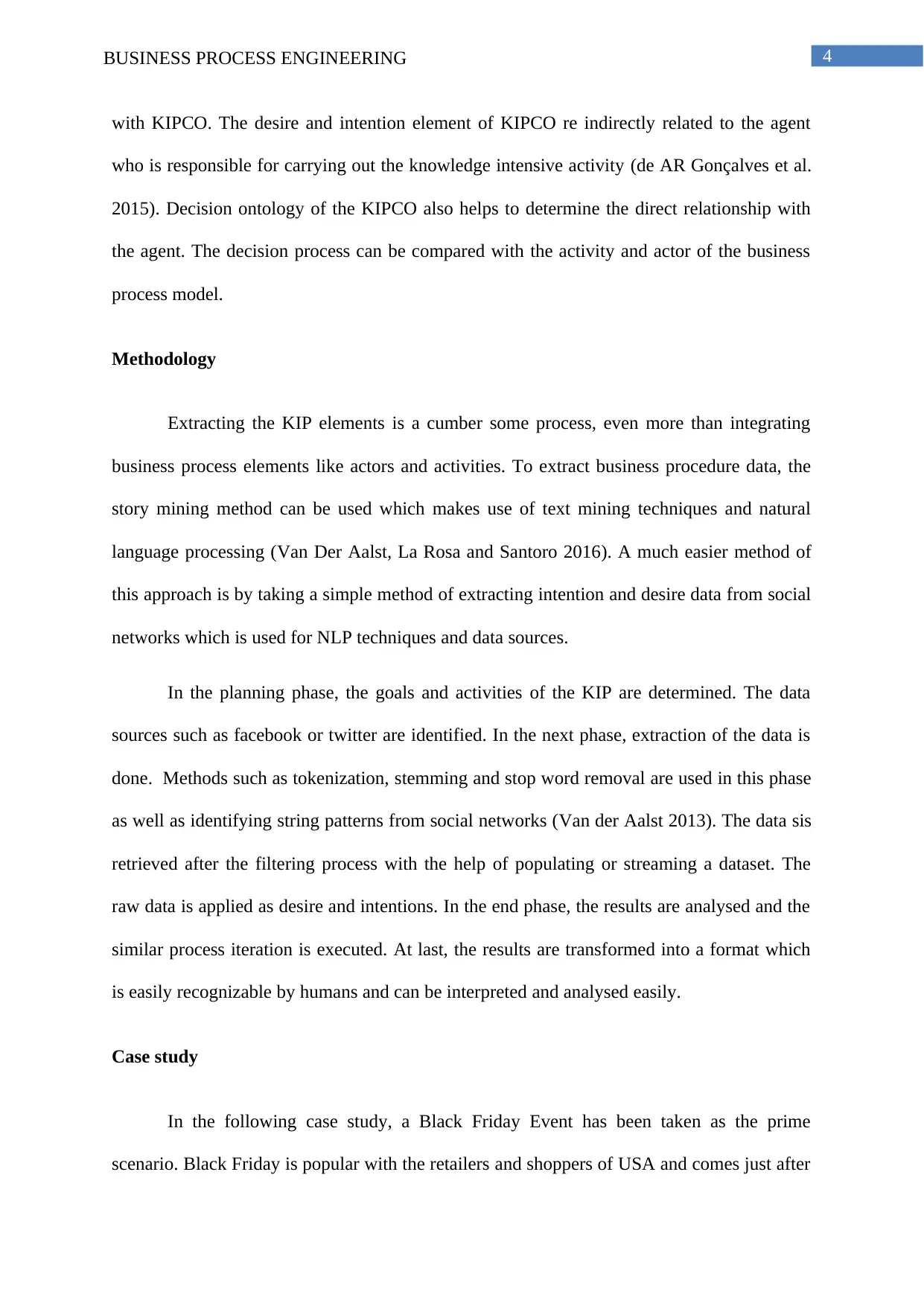
4BUSINESS PROCESS ENGINEERING
with KIPCO. The desire and intention element of KIPCO re indirectly related to the agent
who is responsible for carrying out the knowledge intensive activity (de AR Gonçalves et al.
2015). Decision ontology of the KIPCO also helps to determine the direct relationship with
the agent. The decision process can be compared with the activity and actor of the business
process model.
Methodology
Extracting the KIP elements is a cumber some process, even more than integrating
business process elements like actors and activities. To extract business procedure data, the
story mining method can be used which makes use of text mining techniques and natural
language processing (Van Der Aalst, La Rosa and Santoro 2016). A much easier method of
this approach is by taking a simple method of extracting intention and desire data from social
networks which is used for NLP techniques and data sources.
In the planning phase, the goals and activities of the KIP are determined. The data
sources such as facebook or twitter are identified. In the next phase, extraction of the data is
done. Methods such as tokenization, stemming and stop word removal are used in this phase
as well as identifying string patterns from social networks (Van der Aalst 2013). The data sis
retrieved after the filtering process with the help of populating or streaming a dataset. The
raw data is applied as desire and intentions. In the end phase, the results are analysed and the
similar process iteration is executed. At last, the results are transformed into a format which
is easily recognizable by humans and can be interpreted and analysed easily.
Case study
In the following case study, a Black Friday Event has been taken as the prime
scenario. Black Friday is popular with the retailers and shoppers of USA and comes just after
with KIPCO. The desire and intention element of KIPCO re indirectly related to the agent
who is responsible for carrying out the knowledge intensive activity (de AR Gonçalves et al.
2015). Decision ontology of the KIPCO also helps to determine the direct relationship with
the agent. The decision process can be compared with the activity and actor of the business
process model.
Methodology
Extracting the KIP elements is a cumber some process, even more than integrating
business process elements like actors and activities. To extract business procedure data, the
story mining method can be used which makes use of text mining techniques and natural
language processing (Van Der Aalst, La Rosa and Santoro 2016). A much easier method of
this approach is by taking a simple method of extracting intention and desire data from social
networks which is used for NLP techniques and data sources.
In the planning phase, the goals and activities of the KIP are determined. The data
sources such as facebook or twitter are identified. In the next phase, extraction of the data is
done. Methods such as tokenization, stemming and stop word removal are used in this phase
as well as identifying string patterns from social networks (Van der Aalst 2013). The data sis
retrieved after the filtering process with the help of populating or streaming a dataset. The
raw data is applied as desire and intentions. In the end phase, the results are analysed and the
similar process iteration is executed. At last, the results are transformed into a format which
is easily recognizable by humans and can be interpreted and analysed easily.
Case study
In the following case study, a Black Friday Event has been taken as the prime
scenario. Black Friday is popular with the retailers and shoppers of USA and comes just after
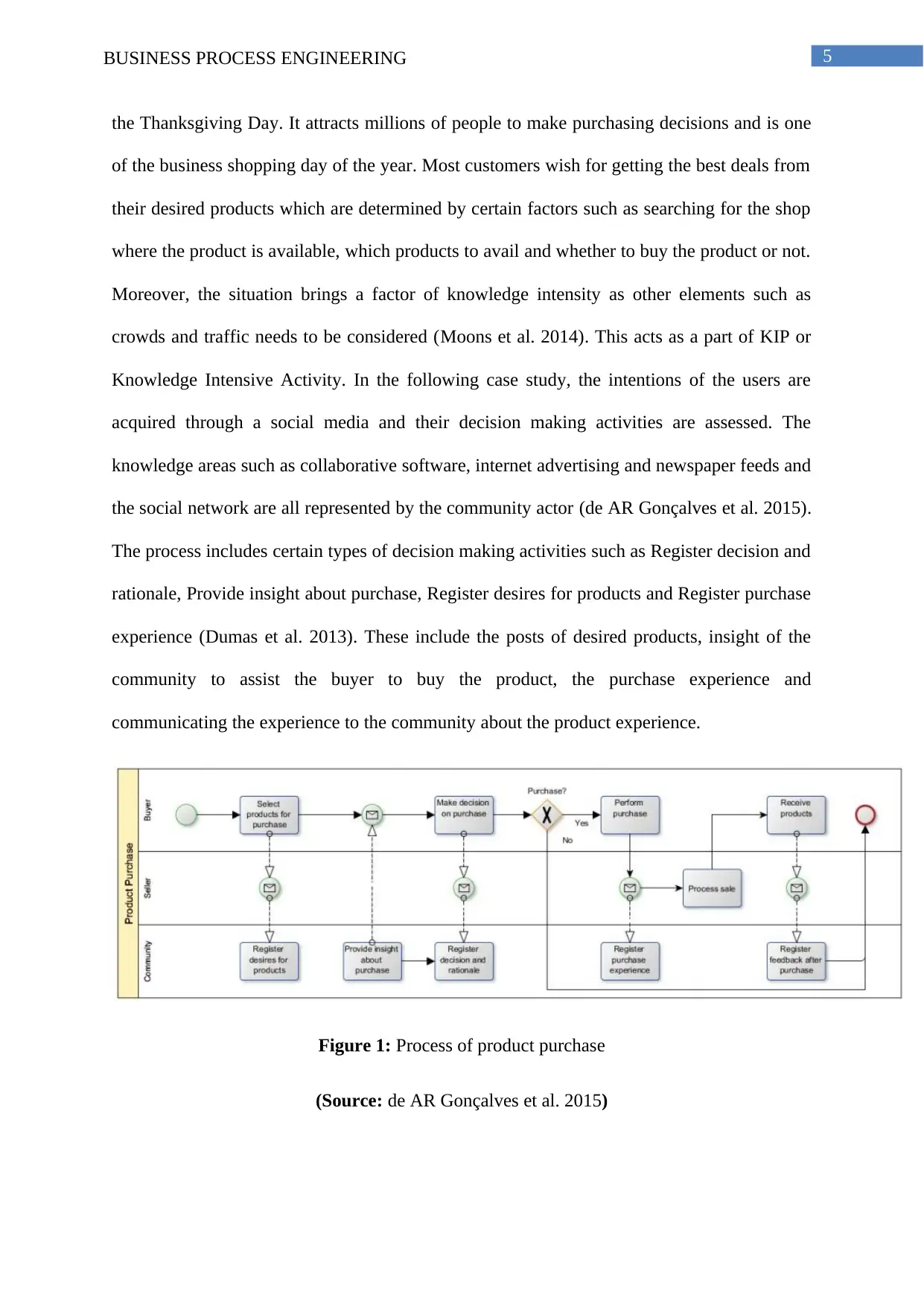
5BUSINESS PROCESS ENGINEERING
the Thanksgiving Day. It attracts millions of people to make purchasing decisions and is one
of the business shopping day of the year. Most customers wish for getting the best deals from
their desired products which are determined by certain factors such as searching for the shop
where the product is available, which products to avail and whether to buy the product or not.
Moreover, the situation brings a factor of knowledge intensity as other elements such as
crowds and traffic needs to be considered (Moons et al. 2014). This acts as a part of KIP or
Knowledge Intensive Activity. In the following case study, the intentions of the users are
acquired through a social media and their decision making activities are assessed. The
knowledge areas such as collaborative software, internet advertising and newspaper feeds and
the social network are all represented by the community actor (de AR Gonçalves et al. 2015).
The process includes certain types of decision making activities such as Register decision and
rationale, Provide insight about purchase, Register desires for products and Register purchase
experience (Dumas et al. 2013). These include the posts of desired products, insight of the
community to assist the buyer to buy the product, the purchase experience and
communicating the experience to the community about the product experience.
Figure 1: Process of product purchase
(Source: de AR Gonçalves et al. 2015)
the Thanksgiving Day. It attracts millions of people to make purchasing decisions and is one
of the business shopping day of the year. Most customers wish for getting the best deals from
their desired products which are determined by certain factors such as searching for the shop
where the product is available, which products to avail and whether to buy the product or not.
Moreover, the situation brings a factor of knowledge intensity as other elements such as
crowds and traffic needs to be considered (Moons et al. 2014). This acts as a part of KIP or
Knowledge Intensive Activity. In the following case study, the intentions of the users are
acquired through a social media and their decision making activities are assessed. The
knowledge areas such as collaborative software, internet advertising and newspaper feeds and
the social network are all represented by the community actor (de AR Gonçalves et al. 2015).
The process includes certain types of decision making activities such as Register decision and
rationale, Provide insight about purchase, Register desires for products and Register purchase
experience (Dumas et al. 2013). These include the posts of desired products, insight of the
community to assist the buyer to buy the product, the purchase experience and
communicating the experience to the community about the product experience.
Figure 1: Process of product purchase
(Source: de AR Gonçalves et al. 2015)
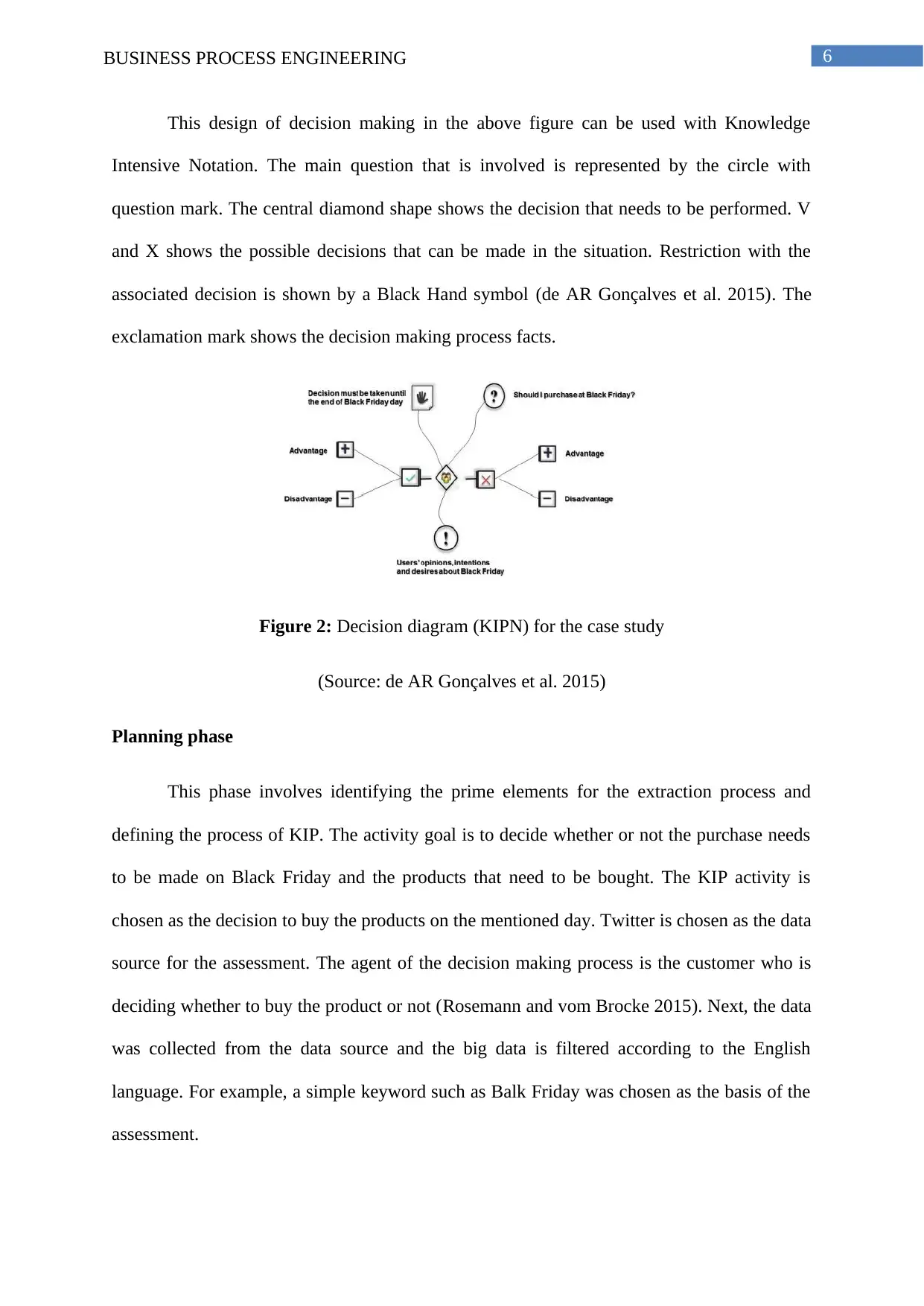
6BUSINESS PROCESS ENGINEERING
This design of decision making in the above figure can be used with Knowledge
Intensive Notation. The main question that is involved is represented by the circle with
question mark. The central diamond shape shows the decision that needs to be performed. V
and X shows the possible decisions that can be made in the situation. Restriction with the
associated decision is shown by a Black Hand symbol (de AR Gonçalves et al. 2015). The
exclamation mark shows the decision making process facts.
Figure 2: Decision diagram (KIPN) for the case study
(Source: de AR Gonçalves et al. 2015)
Planning phase
This phase involves identifying the prime elements for the extraction process and
defining the process of KIP. The activity goal is to decide whether or not the purchase needs
to be made on Black Friday and the products that need to be bought. The KIP activity is
chosen as the decision to buy the products on the mentioned day. Twitter is chosen as the data
source for the assessment. The agent of the decision making process is the customer who is
deciding whether to buy the product or not (Rosemann and vom Brocke 2015). Next, the data
was collected from the data source and the big data is filtered according to the English
language. For example, a simple keyword such as Balk Friday was chosen as the basis of the
assessment.
This design of decision making in the above figure can be used with Knowledge
Intensive Notation. The main question that is involved is represented by the circle with
question mark. The central diamond shape shows the decision that needs to be performed. V
and X shows the possible decisions that can be made in the situation. Restriction with the
associated decision is shown by a Black Hand symbol (de AR Gonçalves et al. 2015). The
exclamation mark shows the decision making process facts.
Figure 2: Decision diagram (KIPN) for the case study
(Source: de AR Gonçalves et al. 2015)
Planning phase
This phase involves identifying the prime elements for the extraction process and
defining the process of KIP. The activity goal is to decide whether or not the purchase needs
to be made on Black Friday and the products that need to be bought. The KIP activity is
chosen as the decision to buy the products on the mentioned day. Twitter is chosen as the data
source for the assessment. The agent of the decision making process is the customer who is
deciding whether to buy the product or not (Rosemann and vom Brocke 2015). Next, the data
was collected from the data source and the big data is filtered according to the English
language. For example, a simple keyword such as Balk Friday was chosen as the basis of the
assessment.
Paraphrase This Document
Need a fresh take? Get an instant paraphrase of this document with our AI Paraphraser
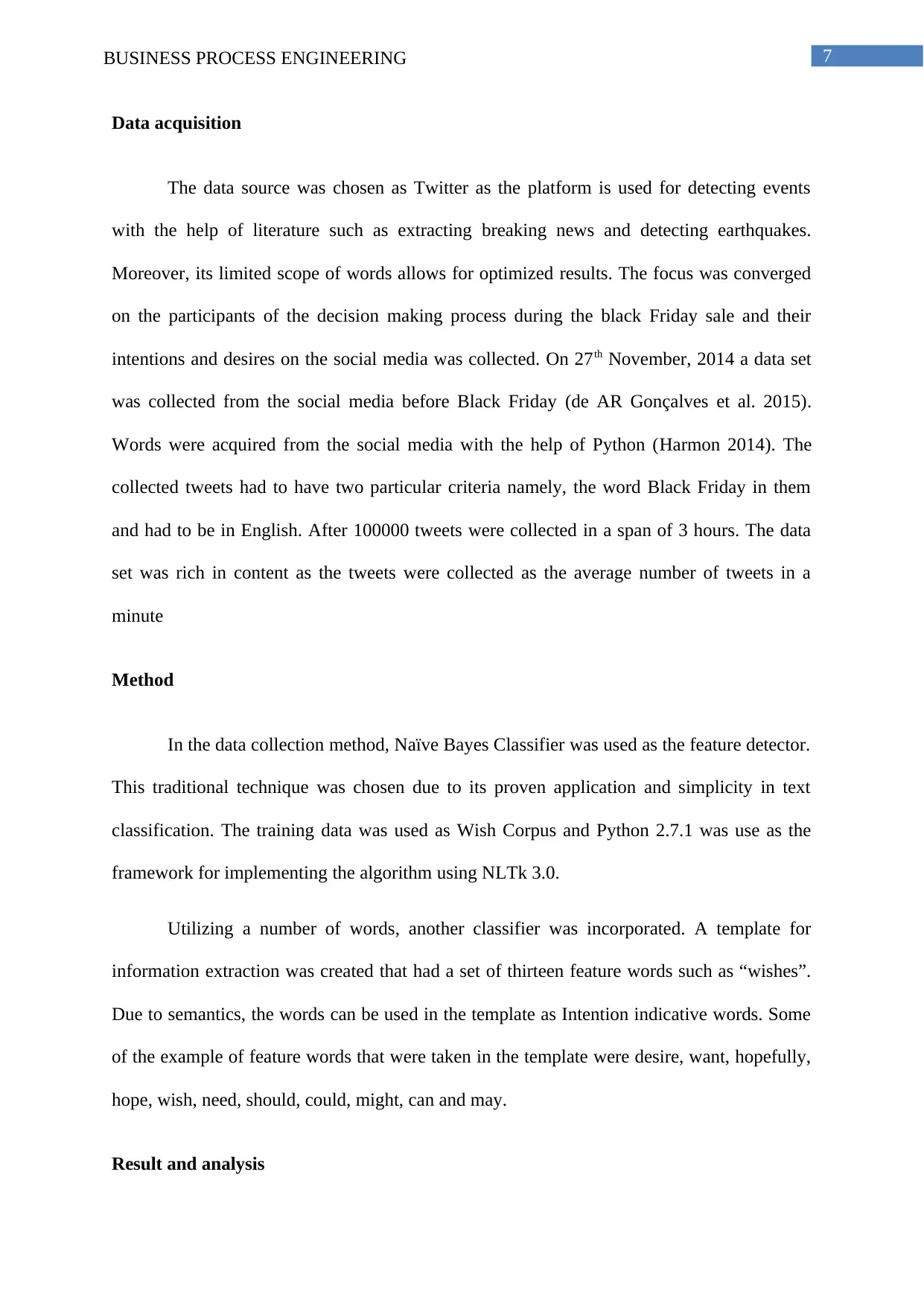
7BUSINESS PROCESS ENGINEERING
Data acquisition
The data source was chosen as Twitter as the platform is used for detecting events
with the help of literature such as extracting breaking news and detecting earthquakes.
Moreover, its limited scope of words allows for optimized results. The focus was converged
on the participants of the decision making process during the black Friday sale and their
intentions and desires on the social media was collected. On 27th November, 2014 a data set
was collected from the social media before Black Friday (de AR Gonçalves et al. 2015).
Words were acquired from the social media with the help of Python (Harmon 2014). The
collected tweets had to have two particular criteria namely, the word Black Friday in them
and had to be in English. After 100000 tweets were collected in a span of 3 hours. The data
set was rich in content as the tweets were collected as the average number of tweets in a
minute
Method
In the data collection method, Naïve Bayes Classifier was used as the feature detector.
This traditional technique was chosen due to its proven application and simplicity in text
classification. The training data was used as Wish Corpus and Python 2.7.1 was use as the
framework for implementing the algorithm using NLTk 3.0.
Utilizing a number of words, another classifier was incorporated. A template for
information extraction was created that had a set of thirteen feature words such as “wishes”.
Due to semantics, the words can be used in the template as Intention indicative words. Some
of the example of feature words that were taken in the template were desire, want, hopefully,
hope, wish, need, should, could, might, can and may.
Result and analysis
Data acquisition
The data source was chosen as Twitter as the platform is used for detecting events
with the help of literature such as extracting breaking news and detecting earthquakes.
Moreover, its limited scope of words allows for optimized results. The focus was converged
on the participants of the decision making process during the black Friday sale and their
intentions and desires on the social media was collected. On 27th November, 2014 a data set
was collected from the social media before Black Friday (de AR Gonçalves et al. 2015).
Words were acquired from the social media with the help of Python (Harmon 2014). The
collected tweets had to have two particular criteria namely, the word Black Friday in them
and had to be in English. After 100000 tweets were collected in a span of 3 hours. The data
set was rich in content as the tweets were collected as the average number of tweets in a
minute
Method
In the data collection method, Naïve Bayes Classifier was used as the feature detector.
This traditional technique was chosen due to its proven application and simplicity in text
classification. The training data was used as Wish Corpus and Python 2.7.1 was use as the
framework for implementing the algorithm using NLTk 3.0.
Utilizing a number of words, another classifier was incorporated. A template for
information extraction was created that had a set of thirteen feature words such as “wishes”.
Due to semantics, the words can be used in the template as Intention indicative words. Some
of the example of feature words that were taken in the template were desire, want, hopefully,
hope, wish, need, should, could, might, can and may.
Result and analysis
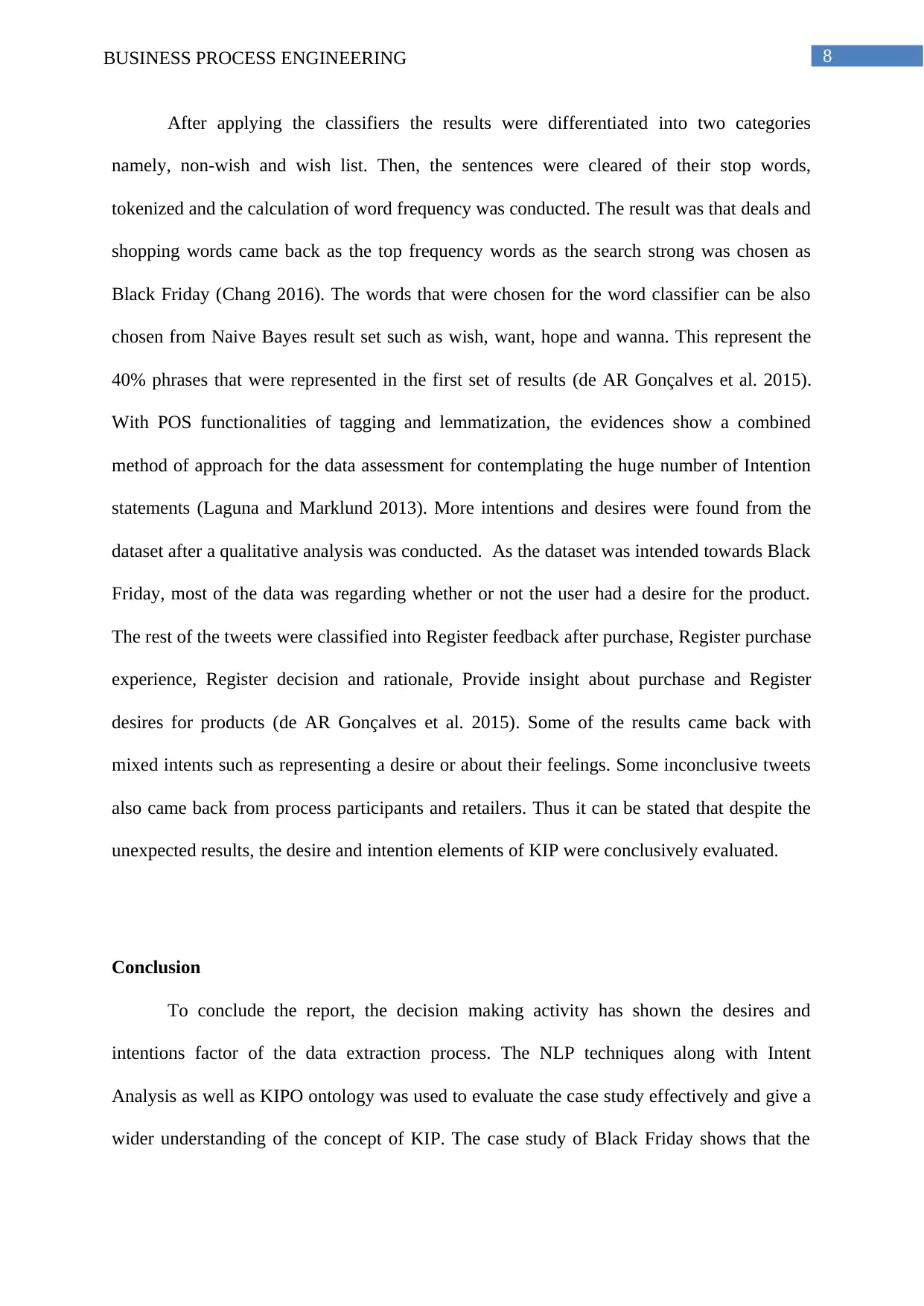
8BUSINESS PROCESS ENGINEERING
After applying the classifiers the results were differentiated into two categories
namely, non-wish and wish list. Then, the sentences were cleared of their stop words,
tokenized and the calculation of word frequency was conducted. The result was that deals and
shopping words came back as the top frequency words as the search strong was chosen as
Black Friday (Chang 2016). The words that were chosen for the word classifier can be also
chosen from Naive Bayes result set such as wish, want, hope and wanna. This represent the
40% phrases that were represented in the first set of results (de AR Gonçalves et al. 2015).
With POS functionalities of tagging and lemmatization, the evidences show a combined
method of approach for the data assessment for contemplating the huge number of Intention
statements (Laguna and Marklund 2013). More intentions and desires were found from the
dataset after a qualitative analysis was conducted. As the dataset was intended towards Black
Friday, most of the data was regarding whether or not the user had a desire for the product.
The rest of the tweets were classified into Register feedback after purchase, Register purchase
experience, Register decision and rationale, Provide insight about purchase and Register
desires for products (de AR Gonçalves et al. 2015). Some of the results came back with
mixed intents such as representing a desire or about their feelings. Some inconclusive tweets
also came back from process participants and retailers. Thus it can be stated that despite the
unexpected results, the desire and intention elements of KIP were conclusively evaluated.
Conclusion
To conclude the report, the decision making activity has shown the desires and
intentions factor of the data extraction process. The NLP techniques along with Intent
Analysis as well as KIPO ontology was used to evaluate the case study effectively and give a
wider understanding of the concept of KIP. The case study of Black Friday shows that the
After applying the classifiers the results were differentiated into two categories
namely, non-wish and wish list. Then, the sentences were cleared of their stop words,
tokenized and the calculation of word frequency was conducted. The result was that deals and
shopping words came back as the top frequency words as the search strong was chosen as
Black Friday (Chang 2016). The words that were chosen for the word classifier can be also
chosen from Naive Bayes result set such as wish, want, hope and wanna. This represent the
40% phrases that were represented in the first set of results (de AR Gonçalves et al. 2015).
With POS functionalities of tagging and lemmatization, the evidences show a combined
method of approach for the data assessment for contemplating the huge number of Intention
statements (Laguna and Marklund 2013). More intentions and desires were found from the
dataset after a qualitative analysis was conducted. As the dataset was intended towards Black
Friday, most of the data was regarding whether or not the user had a desire for the product.
The rest of the tweets were classified into Register feedback after purchase, Register purchase
experience, Register decision and rationale, Provide insight about purchase and Register
desires for products (de AR Gonçalves et al. 2015). Some of the results came back with
mixed intents such as representing a desire or about their feelings. Some inconclusive tweets
also came back from process participants and retailers. Thus it can be stated that despite the
unexpected results, the desire and intention elements of KIP were conclusively evaluated.
Conclusion
To conclude the report, the decision making activity has shown the desires and
intentions factor of the data extraction process. The NLP techniques along with Intent
Analysis as well as KIPO ontology was used to evaluate the case study effectively and give a
wider understanding of the concept of KIP. The case study of Black Friday shows that the

9BUSINESS PROCESS ENGINEERING
methods can be applied to get a feasible data source using KIP along with the generated data
like the product purchase process of Black Friday.
The report effectively evaluates that the information can be extracted to generate the
desires and intentions of a certain process which can be further explored in the future.
The limitations of the report was the limited scope that defined the purchase with one
decision making. Moreover, the NaiveBayes classifier could have been used with Wodlist for
a more conclusive result.
methods can be applied to get a feasible data source using KIP along with the generated data
like the product purchase process of Black Friday.
The report effectively evaluates that the information can be extracted to generate the
desires and intentions of a certain process which can be further explored in the future.
The limitations of the report was the limited scope that defined the purchase with one
decision making. Moreover, the NaiveBayes classifier could have been used with Wodlist for
a more conclusive result.
Secure Best Marks with AI Grader
Need help grading? Try our AI Grader for instant feedback on your assignments.
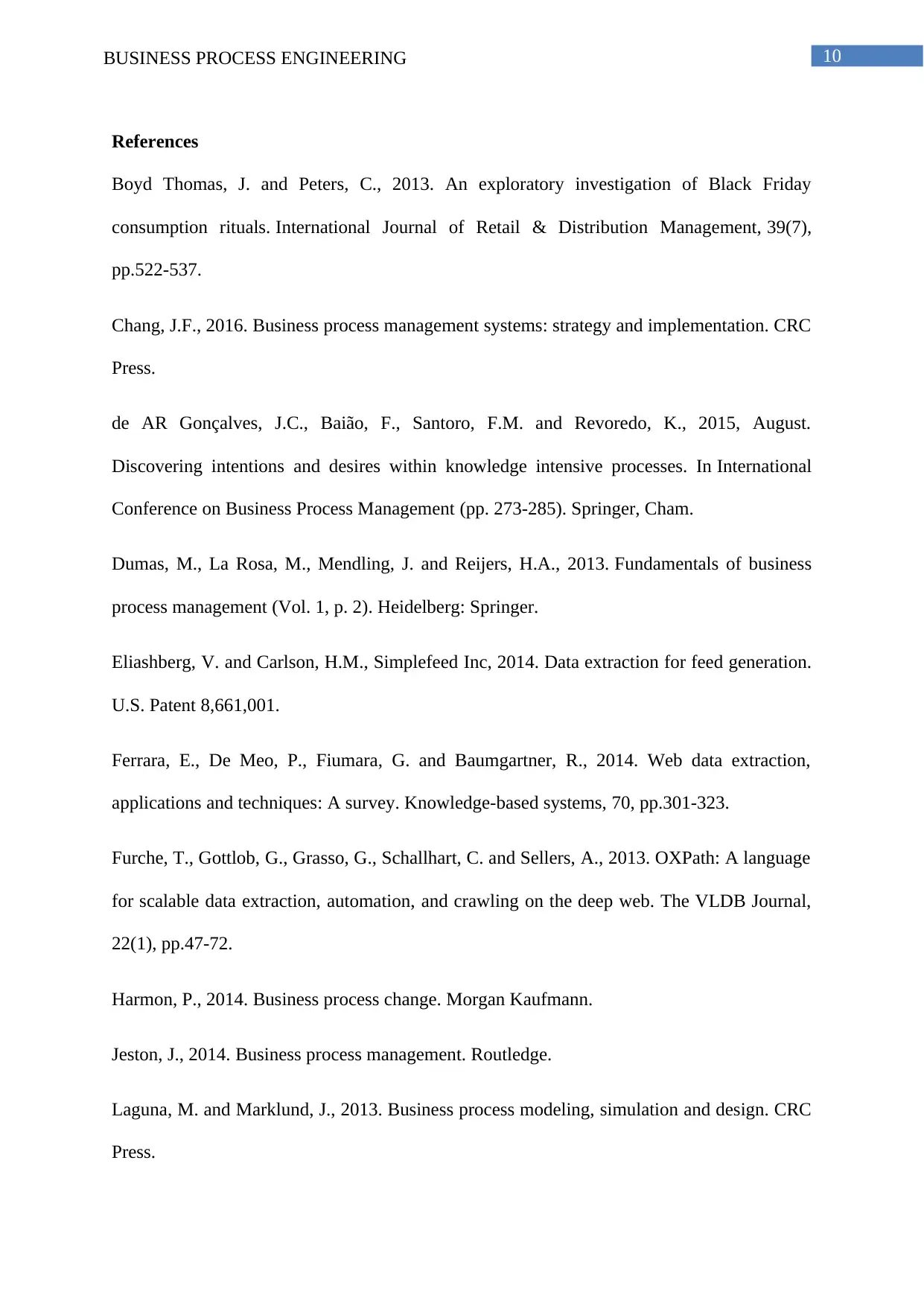
10BUSINESS PROCESS ENGINEERING
References
Boyd Thomas, J. and Peters, C., 2013. An exploratory investigation of Black Friday
consumption rituals. International Journal of Retail & Distribution Management, 39(7),
pp.522-537.
Chang, J.F., 2016. Business process management systems: strategy and implementation. CRC
Press.
de AR Gonçalves, J.C., Baião, F., Santoro, F.M. and Revoredo, K., 2015, August.
Discovering intentions and desires within knowledge intensive processes. In International
Conference on Business Process Management (pp. 273-285). Springer, Cham.
Dumas, M., La Rosa, M., Mendling, J. and Reijers, H.A., 2013. Fundamentals of business
process management (Vol. 1, p. 2). Heidelberg: Springer.
Eliashberg, V. and Carlson, H.M., Simplefeed Inc, 2014. Data extraction for feed generation.
U.S. Patent 8,661,001.
Ferrara, E., De Meo, P., Fiumara, G. and Baumgartner, R., 2014. Web data extraction,
applications and techniques: A survey. Knowledge-based systems, 70, pp.301-323.
Furche, T., Gottlob, G., Grasso, G., Schallhart, C. and Sellers, A., 2013. OXPath: A language
for scalable data extraction, automation, and crawling on the deep web. The VLDB Journal,
22(1), pp.47-72.
Harmon, P., 2014. Business process change. Morgan Kaufmann.
Jeston, J., 2014. Business process management. Routledge.
Laguna, M. and Marklund, J., 2013. Business process modeling, simulation and design. CRC
Press.
References
Boyd Thomas, J. and Peters, C., 2013. An exploratory investigation of Black Friday
consumption rituals. International Journal of Retail & Distribution Management, 39(7),
pp.522-537.
Chang, J.F., 2016. Business process management systems: strategy and implementation. CRC
Press.
de AR Gonçalves, J.C., Baião, F., Santoro, F.M. and Revoredo, K., 2015, August.
Discovering intentions and desires within knowledge intensive processes. In International
Conference on Business Process Management (pp. 273-285). Springer, Cham.
Dumas, M., La Rosa, M., Mendling, J. and Reijers, H.A., 2013. Fundamentals of business
process management (Vol. 1, p. 2). Heidelberg: Springer.
Eliashberg, V. and Carlson, H.M., Simplefeed Inc, 2014. Data extraction for feed generation.
U.S. Patent 8,661,001.
Ferrara, E., De Meo, P., Fiumara, G. and Baumgartner, R., 2014. Web data extraction,
applications and techniques: A survey. Knowledge-based systems, 70, pp.301-323.
Furche, T., Gottlob, G., Grasso, G., Schallhart, C. and Sellers, A., 2013. OXPath: A language
for scalable data extraction, automation, and crawling on the deep web. The VLDB Journal,
22(1), pp.47-72.
Harmon, P., 2014. Business process change. Morgan Kaufmann.
Jeston, J., 2014. Business process management. Routledge.
Laguna, M. and Marklund, J., 2013. Business process modeling, simulation and design. CRC
Press.
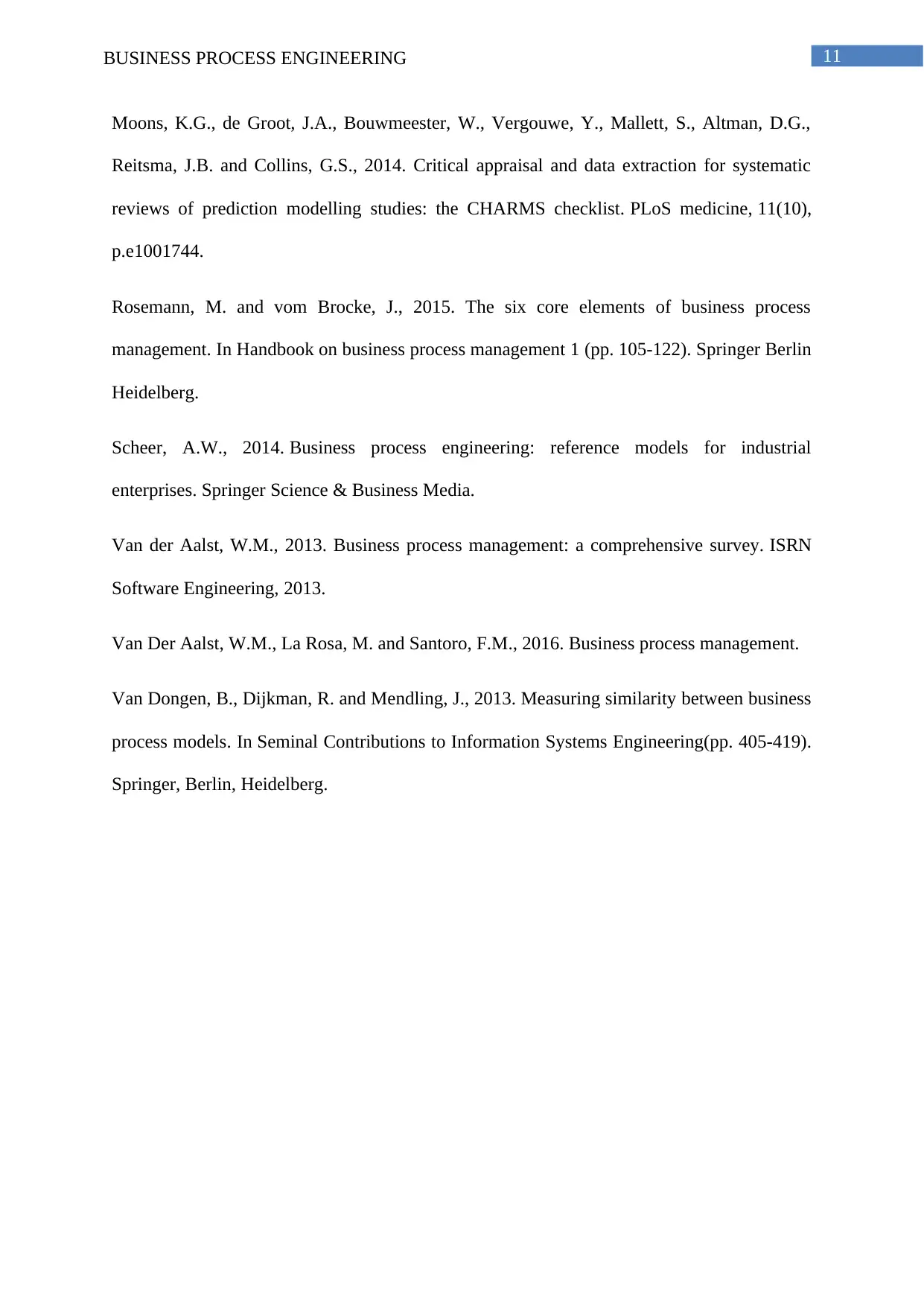
11BUSINESS PROCESS ENGINEERING
Moons, K.G., de Groot, J.A., Bouwmeester, W., Vergouwe, Y., Mallett, S., Altman, D.G.,
Reitsma, J.B. and Collins, G.S., 2014. Critical appraisal and data extraction for systematic
reviews of prediction modelling studies: the CHARMS checklist. PLoS medicine, 11(10),
p.e1001744.
Rosemann, M. and vom Brocke, J., 2015. The six core elements of business process
management. In Handbook on business process management 1 (pp. 105-122). Springer Berlin
Heidelberg.
Scheer, A.W., 2014. Business process engineering: reference models for industrial
enterprises. Springer Science & Business Media.
Van der Aalst, W.M., 2013. Business process management: a comprehensive survey. ISRN
Software Engineering, 2013.
Van Der Aalst, W.M., La Rosa, M. and Santoro, F.M., 2016. Business process management.
Van Dongen, B., Dijkman, R. and Mendling, J., 2013. Measuring similarity between business
process models. In Seminal Contributions to Information Systems Engineering(pp. 405-419).
Springer, Berlin, Heidelberg.
Moons, K.G., de Groot, J.A., Bouwmeester, W., Vergouwe, Y., Mallett, S., Altman, D.G.,
Reitsma, J.B. and Collins, G.S., 2014. Critical appraisal and data extraction for systematic
reviews of prediction modelling studies: the CHARMS checklist. PLoS medicine, 11(10),
p.e1001744.
Rosemann, M. and vom Brocke, J., 2015. The six core elements of business process
management. In Handbook on business process management 1 (pp. 105-122). Springer Berlin
Heidelberg.
Scheer, A.W., 2014. Business process engineering: reference models for industrial
enterprises. Springer Science & Business Media.
Van der Aalst, W.M., 2013. Business process management: a comprehensive survey. ISRN
Software Engineering, 2013.
Van Der Aalst, W.M., La Rosa, M. and Santoro, F.M., 2016. Business process management.
Van Dongen, B., Dijkman, R. and Mendling, J., 2013. Measuring similarity between business
process models. In Seminal Contributions to Information Systems Engineering(pp. 405-419).
Springer, Berlin, Heidelberg.
1 out of 12
Related Documents
Your All-in-One AI-Powered Toolkit for Academic Success.
+13062052269
info@desklib.com
Available 24*7 on WhatsApp / Email
![[object Object]](/_next/static/media/star-bottom.7253800d.svg)
Unlock your academic potential
© 2024 | Zucol Services PVT LTD | All rights reserved.





